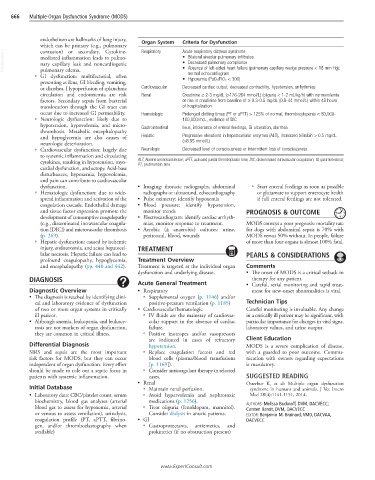Page 1319 - Cote clinical veterinary advisor dogs and cats 4th
P. 1319
666 Multiple-Organ Dysfunction Syndrome (MODS)
endothelium are hallmarks of lung injury, Organ System Criteria for Dysfunction
which can be primary (e.g., pulmonary Respiratory Acute respiratory distress syndrome
VetBooks.ir mediated inflammation leads to pulmo- • Bilateral alveolar pulmonary infiltrates
contusion) or secondary. Cytokine-
• Decreased pulmonary compliance
nary capillary leak and noncardiogenic
• Absence of left-sided heart failure (pulmonary capillary wedge pressure < 18 mm Hg);
pulmonary edema.
○ GI dysfunction: multifactorial, often normal echocardiogram
presenting as ileus, GI bleeding, vomiting, • Hypoxemia (PaO 2/FIO 2 < 300)
or diarrhea. Hypoperfusion of splanchnic Cardiovascular Decreased cardiac output, decreased contractility, hypotension, arrhythmias
circulation and endotoxemia are risk Renal Creatinine ≥ 2-3 mg/dL (>176-264 mmol/L) (oliguria < 1-2 mL/kg/h) with normovolemia
factors. Secondary sepsis from bacterial or rise in creatinine from baseline of ≥ 0.3-0.5 mg/dL (0.8-44 mmol/L) within 48 hours
translocation through the GI tract can of hospitalization
occur due to increased GI permeability. Hematologic Prolonged clotting times (PT or aPTT) > 125% of normal, thrombocytopenia < 80,000-
○ Neurologic dysfunction: likely due to 100,000/mcL, evidence of DIC
hypotension, hypovolemia, and micro- Gastrointestinal Ileus, intolerance of enteral feedings, GI ulceration, diarrhea
thrombosis. Metabolic encephalopathy
and hypoglycemia are also causes of Hepatic Progressive elevations in hepatocellular enzymes (ALT), increased bilirubin > 0.5 mg/dL
neurologic deterioration. (>8.55 mmol/L)
○ Cardiovascular dysfunction: largely due Neurologic Decreased level of consciousness or intermittent loss of consciousness
to systemic inflammation and circulating
cytokines, resulting in hypotension, myo- ALT, Alanine aminotransferase; aPTT, activated partial thromboplastin time; DIC, disseminated intravascular coagulation; GI, gastrointestinal;
PT, prothrombin time.
cardial dysfunction, and ectopy. Acid-base
disturbances, hypoxemia, hypovolemia,
and pain can contribute to cardiovascular
dysfunction. • Imaging: thoracic radiographs, abdominal ○ Start enteral feedings as soon as possible
○ Hematologic dysfunction: due to wide- radiographs or ultrasound, echocardiography or glutamate to support enterocyte health
spread inflammation and activation of the • Pulse oximetry: identify hypoxemia if full enteral feedings are not tolerated.
coagulation cascade. Endothelial damage • Blood pressure: identify hypotension,
and tissue factor expression promote the monitor trends PROGNOSIS & OUTCOME
development of consumptive coagulopathy • Electrocardiogram: identify cardiac arrhyth-
(e.g., disseminated intravascular coagula- mias, monitor response to treatment. MODS conveys a poor prognosis: mortality rate
tion [DIC]) and microvascular thrombosis • Aerobic (± anaerobic) cultures: urine, for dogs with abdominal sepsis is 70% with
(p. 269). peritoneal, blood, wounds MODS versus 50% without. In people, failure
○ Hepatic dysfunction: caused by ischemic of more than four organs is almost 100% fatal.
injury, endotoxemia, and acute hepatocel- TREATMENT
lular necrosis. Hepatic failure can lead to PEARLS & CONSIDERATIONS
profound coagulopathy, hypoglycemia, Treatment Overview
and encephalopathy (pp. 440 and 442). Treatment is targeted at the individual organ Comments
dysfunction and underlying disease. • The onset of MODS is a critical setback in
DIAGNOSIS therapy for any patient.
Acute General Treatment • Careful, serial monitoring and rapid treat-
Diagnostic Overview • Respiratory ment for new-onset abnormalities is vital.
• The diagnosis is reached by identifying clini- ○ Supplemental oxygen (p. 1146) and/or
cal and laboratory evidence of dysfunction positive-pressure ventilation (p. 1185) Technician Tips
of two or more organ systems in critically • Cardiovascular/hematologic Careful monitoring is invaluable. Any change
ill patient. ○ IV fluids are the mainstay of cardiovas- in a critically ill patient may be significant, with
• Although anemia, leukopenia, and leukocy- cular support in the absence of cardiac particular importance for changes in vital signs,
tosis are not markers of organ dysfunction, failure. laboratory values, and urine output.
they are common in critical illness. ○ Positive inotropes and/or vasopressors
are indicated in cases of refractory Client Education
Differential Diagnosis hypotension. MODS is a severe complication of disease,
SIRS and sepsis are the most important ○ Replace coagulation factors and red with a guarded to poor outcome. Commu-
risk factors for MODS, but they can occur blood cells (plasma/blood transfusions nication with owners regarding expectations
independent of organ dysfunction. Every effort [p. 1169]). is mandatory.
should be made to rule out a septic focus in ○ Consider anticoagulant therapy in selected
patients with systemic inflammation. cases. SUGGESTED READING
• Renal Osterbur K, et al: Multiple organ dysfunction
Initial Database ○ Maintain renal perfusion. syndrome in humans and animals. J Vet Intern
• Laboratory data: CBC/platelet count, serum ○ Avoid hypervolemia and nephrotoxic Med 28(4):1141-1151, 2014.
biochemistry, blood gas analyses (arterial medications (p. 1256). AUTHORS: Melissa Bucknoff, DVM, DACVECC;
blood gas to assess for hypoxemia, arterial ○ Treat oliguria (fenoldopam, mannitol). Carsten Bandt, DVM, DACVECC
or venous to assess ventilation), urinalysis, Consider dialysis in anuric patients. EDITOR: Benjamin M. Brainard, VMD, DACVAA,
coagulation profile (PT, aPTT, fibrino- • GI DACVECC
gen, and/or thromboelastography when ○ Gastroprotectants, antiemetics, and
available) prokinetics (if no obstruction present)
www.ExpertConsult.com

